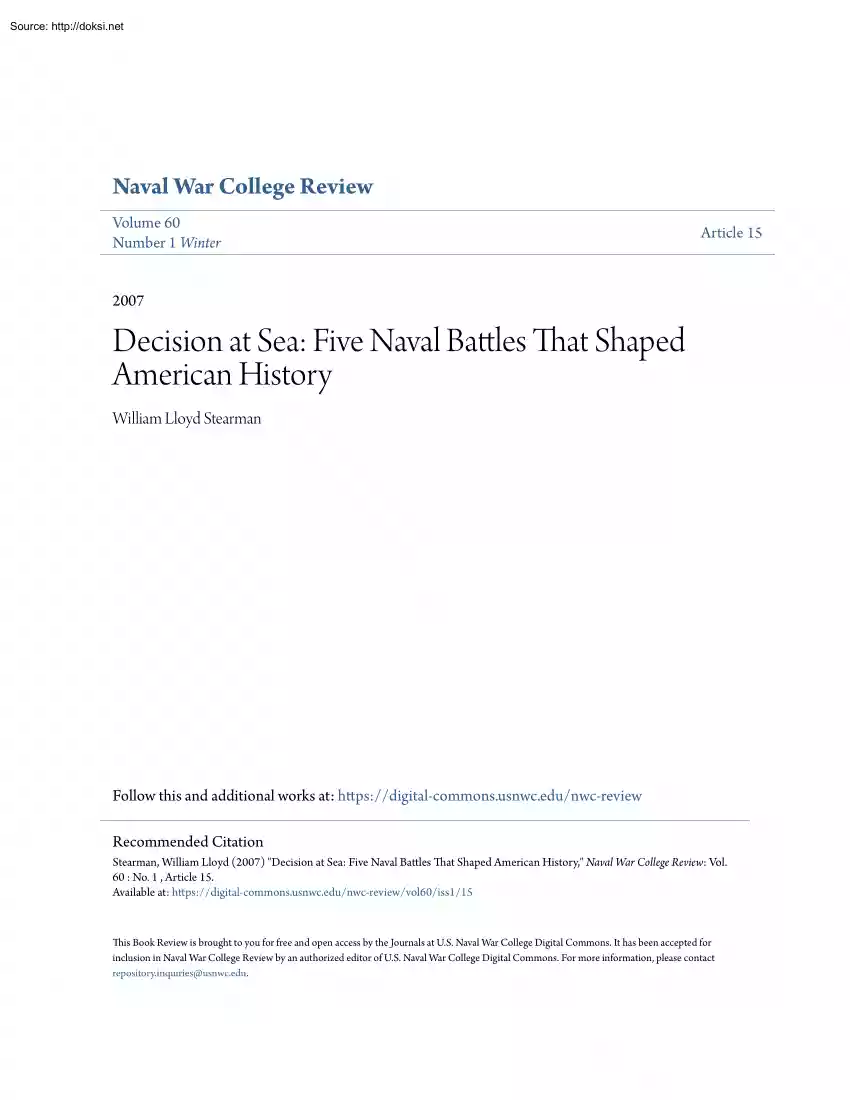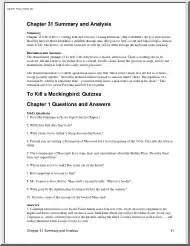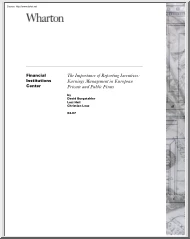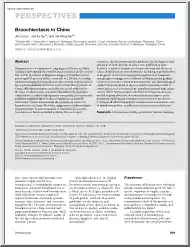A doksi online olvasásához kérlek jelentkezz be!

A doksi online olvasásához kérlek jelentkezz be!
Nincs még értékelés. Legyél Te az első!
Mit olvastak a többiek, ha ezzel végeztek?
Tartalmi kivonat
Source: http://doksi.net Naval War College Review Volume 60 Number 1 Winter Article 15 2007 Decision at Sea: Five Naval Battles That Shaped American History William Lloyd Stearman Follow this and additional works at: https://digital-commons.usnwcedu/nwc-review Recommended Citation Stearman, William Lloyd (2007) "Decision at Sea: Five Naval Battles That Shaped American History," Naval War College Review: Vol. 60 : No. 1 , Article 15 Available at: https://digital-commons.usnwcedu/nwc-review/vol60/iss1/15 This Book Review is brought to you for free and open access by the Journals at U.S Naval War College Digital Commons It has been accepted for inclusion in Naval War College Review by an authorized editor of U.S Naval War College Digital Commons For more information, please contact repository.inquiries@usnwcedu Color profile: Disabled Composite Default screen Source: http://doksi.net 148 Stearman: Decision at Sea: Five Naval Battles That Shaped American History NAVAL
WAR COLLEGE REVIEW Malcolm Brown has done a great service for those interested in Lawrence’s ideas by including them here. In conclusion, this is a superb addition to the literature on guerrilla warfare. I enjoyed reading it. Lawrence’s prose and clarity of thinking and exposition made it doubly enjoyable. AHMED HASHIM Naval War College Symonds, Craig L. Decision at Sea: Five Naval Battles That Shaped American History New York: Oxford Univ. Press, 2005 378pp $30 What history buff could possibly resist the subtitle “Five Naval Battles That Shaped American History”? Those so enticed will not be disappointed in Craig Symond’s exceptionally well written and fascinating accounts of these American naval battles: Oliver Hazard Perry’s far-reaching victory over the British in the 10 September 1813 battle for Lake Erie; the 8–9 March 1862 battle of Hampton Roads (which ended in a draw) between America’s first ironclad ships, USS Monitor and CSS Virginia; the 1 May 1898
battle of Manila Bay; the 4 June 1942 battle of Midway; and the 18 April 1988 Operation PRAYING MANTIS in the Persian Gulf. Because the American navy was absent, Symonds does not list the most crucial naval battle in American history, the early September 1781 battle of the Capes, in which a French fleet prevented the British from resupplying Lord Charles Cornwallis’s besieged troops at Yorktown. Nonetheless, he provides a detailed account of this battle, describing it as “the battle that Published by U.S Naval War College Digital Commons, 2007 C:WIPNWCRNWC Review Winter 2007.vp Wednesday, February 28, 2007 8:14:50 AM secured American independence.” Symonds places special emphasis on crucial command decisions. In this case, he notes, for example, that at a critical moment the British commander, Rear Admiral Thomas Graves, hoisted a flag signal whose ambiguity resulted in failure to concentrate the fleet’s fire on the French, who in large measure prevailed because of this
blunder. This book’s considerable historical value resides as much in Symonds’s highly interesting and detailed description of the British background as in the actual battles. For example, most of us learned in school that impressment by the British of American sailors into the Royal Navy was the prime cause of war in 1812but I was surprised to read here that some ten thousand were so impressed. While we all knew about Perry’s victory at Lake Erie and his famous report, “We have met the enemy and he is ours,” few have a true idea of its significance. In Symonds’s words, “Perry’s victory secured the northwestern frontier for the United States”the threat that greatly concerned us. Symonds’s descriptions of the conditions in which men fought at sea are also masterful. This is especially so in his comparison of the conditions on sailing ships with those of the ironclads, Monitor and Virginia. Symonds notes that in terms of casualties Virginia inflicted before
Monitor’s arrival “the worst defeat in the history of the United States Navy until Pearl Harbor.” The episode clearly spelled the end of an era in naval warfare. The lopsided 1898 victory over the Spanish at Manila Bay, for its part, left the United States “an acknowledged world power” 1 Color profile: Disabled Composite Default screen Source: http://doksi.net Naval War College Review, Vol. 60 [2007], No 1, Art 15 and an “empire.” The close-run victory at Midway confirmed the primacy of aircraft carriers and ensured U.S control of the western Pacific PRAYING MANTIS was thrown in mainly to demonstrate that new U.S weapons do workalbeit, in this case, against a rather feeble Iranian foe. Curiously, Symonds fails to note that a few months earlier, the battleship USS Iowa had dramatically demonstrated a far greater peacekeeping capability than the extensive, missile-equipped fleet he described. WILLIAM LLOYD STEARMAN Secretary of the Navy’s Advisory Subcommittee on
Naval History Divila, Tony, Marc J. Epstein, and Robert Shelton. Making Innovation Work: How to Manage It, Measure It, and Profit from It Upper Saddle River, N.J: Wharton School, 2006 334pp $2999 Innovation is one of the four pillars of the U.S Defense Department’s Transformation Plan Innovation has nudged its way into the mission statements and strategies of most business and government organizations, because it is essential for competitive positioning and sustained performance. Yet in spite of executive proclamations and substantial investment, a majority of organizations report disappointing innovation results. Making Innovation Work does a thorough job of converting the concept of innovation into a practical management framework. Although the book is research-based and two of its authors are academics, it provides practical tools and techniques for managing the end-to-end innovation process. It also debunks several innovation myths, such as creativity and management discipline
https://digital-commons.usnwcedu/nwc-review/vol60/iss1/15 C:WIPNWCRNWC Review Winter 2007.vp Wednesday, February 28, 2007 8:14:51 AM BOOK REVIEWS 149 being incompatible. Examples and vocabulary are clearly geared to a business audience. There are several excellent books on military innovation, but most are analytical and retrospective. This is a “hands on” book about the management of innovation, and leaders of national security organizations will appreciate the relevance of the book’s framework. This book is geared to leaders who manage innovation in large successful organizations. Paradoxically, large successful organizations typically have the weakest innovation results, because innovation requires deviation from the practices and technology that have served them so well over the years. At times the book becomes a bit repetitive, and word or phrase usage can become confusing, but the liberal use of graphics and text boxes to deliver important insights, examples, and models
is quite effective. The authors’ innovation model is a four-cell matrix. The two axes (Technology, Business Model) are subdivided into “New” and “Existing.” The four cells categorize distinct types of innovation, labeled “Incremental,” “Business Model Semi-Radical,” “Technology Semi-Radical,” and “Radical.” An innovation project utilizing existing technology but employing a new way of conducting business is categorized as “Semi-Radical.” An example is iPod/ iTunes, which uses existing technology but dramatically alters the way music is acquired. This type of product is called a “disruptive innovation.” It fundamentally changes the marketplace and the organization’s competitive position in it. The authors’ premise is that the category of innovation is an important consideration, since it sets the stage for 2
WAR COLLEGE REVIEW Malcolm Brown has done a great service for those interested in Lawrence’s ideas by including them here. In conclusion, this is a superb addition to the literature on guerrilla warfare. I enjoyed reading it. Lawrence’s prose and clarity of thinking and exposition made it doubly enjoyable. AHMED HASHIM Naval War College Symonds, Craig L. Decision at Sea: Five Naval Battles That Shaped American History New York: Oxford Univ. Press, 2005 378pp $30 What history buff could possibly resist the subtitle “Five Naval Battles That Shaped American History”? Those so enticed will not be disappointed in Craig Symond’s exceptionally well written and fascinating accounts of these American naval battles: Oliver Hazard Perry’s far-reaching victory over the British in the 10 September 1813 battle for Lake Erie; the 8–9 March 1862 battle of Hampton Roads (which ended in a draw) between America’s first ironclad ships, USS Monitor and CSS Virginia; the 1 May 1898
battle of Manila Bay; the 4 June 1942 battle of Midway; and the 18 April 1988 Operation PRAYING MANTIS in the Persian Gulf. Because the American navy was absent, Symonds does not list the most crucial naval battle in American history, the early September 1781 battle of the Capes, in which a French fleet prevented the British from resupplying Lord Charles Cornwallis’s besieged troops at Yorktown. Nonetheless, he provides a detailed account of this battle, describing it as “the battle that Published by U.S Naval War College Digital Commons, 2007 C:WIPNWCRNWC Review Winter 2007.vp Wednesday, February 28, 2007 8:14:50 AM secured American independence.” Symonds places special emphasis on crucial command decisions. In this case, he notes, for example, that at a critical moment the British commander, Rear Admiral Thomas Graves, hoisted a flag signal whose ambiguity resulted in failure to concentrate the fleet’s fire on the French, who in large measure prevailed because of this
blunder. This book’s considerable historical value resides as much in Symonds’s highly interesting and detailed description of the British background as in the actual battles. For example, most of us learned in school that impressment by the British of American sailors into the Royal Navy was the prime cause of war in 1812but I was surprised to read here that some ten thousand were so impressed. While we all knew about Perry’s victory at Lake Erie and his famous report, “We have met the enemy and he is ours,” few have a true idea of its significance. In Symonds’s words, “Perry’s victory secured the northwestern frontier for the United States”the threat that greatly concerned us. Symonds’s descriptions of the conditions in which men fought at sea are also masterful. This is especially so in his comparison of the conditions on sailing ships with those of the ironclads, Monitor and Virginia. Symonds notes that in terms of casualties Virginia inflicted before
Monitor’s arrival “the worst defeat in the history of the United States Navy until Pearl Harbor.” The episode clearly spelled the end of an era in naval warfare. The lopsided 1898 victory over the Spanish at Manila Bay, for its part, left the United States “an acknowledged world power” 1 Color profile: Disabled Composite Default screen Source: http://doksi.net Naval War College Review, Vol. 60 [2007], No 1, Art 15 and an “empire.” The close-run victory at Midway confirmed the primacy of aircraft carriers and ensured U.S control of the western Pacific PRAYING MANTIS was thrown in mainly to demonstrate that new U.S weapons do workalbeit, in this case, against a rather feeble Iranian foe. Curiously, Symonds fails to note that a few months earlier, the battleship USS Iowa had dramatically demonstrated a far greater peacekeeping capability than the extensive, missile-equipped fleet he described. WILLIAM LLOYD STEARMAN Secretary of the Navy’s Advisory Subcommittee on
Naval History Divila, Tony, Marc J. Epstein, and Robert Shelton. Making Innovation Work: How to Manage It, Measure It, and Profit from It Upper Saddle River, N.J: Wharton School, 2006 334pp $2999 Innovation is one of the four pillars of the U.S Defense Department’s Transformation Plan Innovation has nudged its way into the mission statements and strategies of most business and government organizations, because it is essential for competitive positioning and sustained performance. Yet in spite of executive proclamations and substantial investment, a majority of organizations report disappointing innovation results. Making Innovation Work does a thorough job of converting the concept of innovation into a practical management framework. Although the book is research-based and two of its authors are academics, it provides practical tools and techniques for managing the end-to-end innovation process. It also debunks several innovation myths, such as creativity and management discipline
https://digital-commons.usnwcedu/nwc-review/vol60/iss1/15 C:WIPNWCRNWC Review Winter 2007.vp Wednesday, February 28, 2007 8:14:51 AM BOOK REVIEWS 149 being incompatible. Examples and vocabulary are clearly geared to a business audience. There are several excellent books on military innovation, but most are analytical and retrospective. This is a “hands on” book about the management of innovation, and leaders of national security organizations will appreciate the relevance of the book’s framework. This book is geared to leaders who manage innovation in large successful organizations. Paradoxically, large successful organizations typically have the weakest innovation results, because innovation requires deviation from the practices and technology that have served them so well over the years. At times the book becomes a bit repetitive, and word or phrase usage can become confusing, but the liberal use of graphics and text boxes to deliver important insights, examples, and models
is quite effective. The authors’ innovation model is a four-cell matrix. The two axes (Technology, Business Model) are subdivided into “New” and “Existing.” The four cells categorize distinct types of innovation, labeled “Incremental,” “Business Model Semi-Radical,” “Technology Semi-Radical,” and “Radical.” An innovation project utilizing existing technology but employing a new way of conducting business is categorized as “Semi-Radical.” An example is iPod/ iTunes, which uses existing technology but dramatically alters the way music is acquired. This type of product is called a “disruptive innovation.” It fundamentally changes the marketplace and the organization’s competitive position in it. The authors’ premise is that the category of innovation is an important consideration, since it sets the stage for 2



